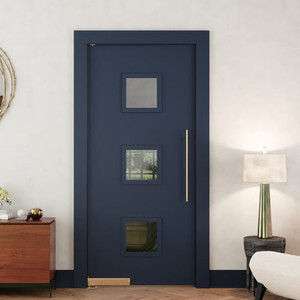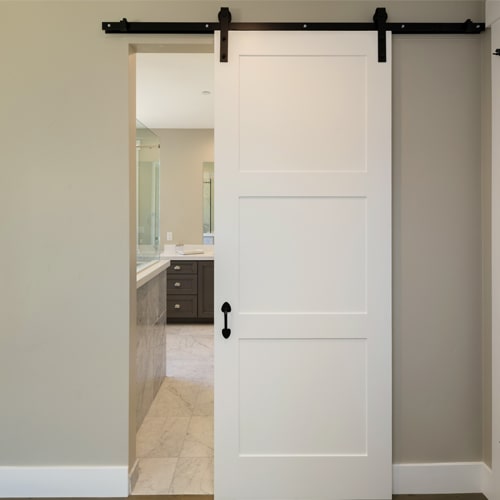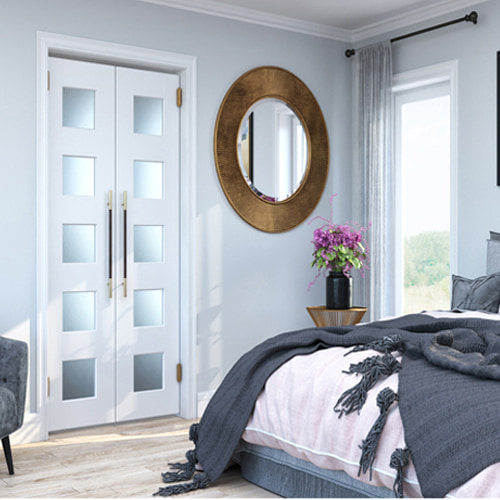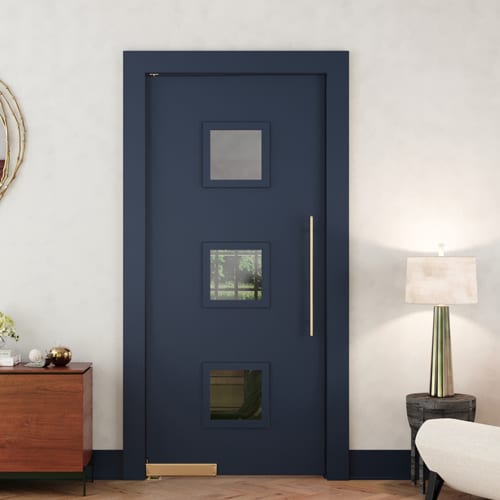
Choosing the Perfect Door Style for Your Home: Sliding, Swinging, Bifold, or Hinged?
Choosing the Perfect Door Style for Your Home: Sliding, Swinging, Bifold, or Hinged?
Doors are not just transitions from one room to another but are integral elements of interior design that can significantly impact the functionality, aesthetics, and overall home experience. As a homeowner, interior design enthusiast, or part of the vibrant DIY community, selecting the right modern door style for your space is an important decision that requires careful consideration of various factors and personal preferences.
Introduction to Door Styles
Doors play a crucial role in the flow and dynamics of a living space. They can be the focal point of a room, a boundary, or a blending element, depending on the design and usage. The type of door you choose can affect the perceived size of a room, movement within it, and the overall design aesthetic. In this comprehensive guide, we will help you understand the key differences between four popular door styles—sliding, swinging, bifold, and hinged—and how to pick the perfect one for your home.
Importance of Selecting the Right Door for Your Space
Choosing a door might seem like a mundane task, but in the realm of design, it's a decision that shouldn't be taken lightly. The right door can enhance the architectural vision of the space and reflect the homeowner's lifestyle, while an ill-fitted one might stick out like a sore thumb. Functionality is paramount, followed closely by design and material considerations.
Overview of Sliding, Swinging, Bifold, and Hinged Doors
Each door type has its own set of benefits and attributes. Sliding doors, also known as bypass doors, are sleek and space-saving, making them perfect for contemporary spaces. Swinging doors, also called hinged doors, are the classic choice, offering a wide range of designs and materials, suitable for any room. Bifold doors fold neatly to one side, maximizing space efficiency. And last but not least, hinged doors, with their traditional appeal, provide full clearance and come in a variety of styles.
Understanding Sliding Doors
Sliding doors, often used in contemporary and modern designs, are a flexible choice that can suit various spaces and preferences.
Definition and Features of Sliding Doors
Sliding doors operate by moving horizontally along a track, allowing for a wide opening without the need for exterior space for the door to swing open. They come in various materials, from traditional wood to modern glass, and can offer a variety of mechanisms for smooth operation.
Advantages of Sliding Doors
Space-Saving Design
The main benefit of sliding doors is their ability to save space. They are perfect for rooms where a swinging door would be impractical due to layout or size constraints.
Modern and Sleek Aesthetics
Incorporating a sliding door into your space can instantly add a touch of modernity and a streamlined look, especially when using glass panels that allow light to flow through.
Versatility in Design Configurations
Sliding doors are highly versatile, allowing multiple panels to slide behind one another or into wall pockets, providing customization options to match any design scheme.
Considerations When Choosing Sliding Doors
When opting for sliding doors, it's important to consider the intended use and the available space. They are not ideal for high-traffic areas in a home with young children due to safety concerns. Additionally, weatherproofing should be a priority for exterior sliding doors to ensure energy efficiency and protection from the elements.
Exploring Swinging Doors
Swinging doors, also known as hinged doors, embody a traditional and versatile design that can be a beautiful addition to various home styles.
Definition and Features of Swinging Doors
Hinged doors operate by pivoting on hinges, which attach to a door jamb. This classic design is available in single and double configurations, and the door can swing in towards the room or out into a hallway or exterior space.
Advantages of Swinging Doors
Wide Opening for Traffic Flow
Swinging doors offer a wide opening, making them suitable for high-traffic areas where you need full access to the room, such as the kitchen or living room.
Classic and Traditional Design
For those who appreciate the charm of traditional home elements, swinging doors provide an enduring, classic look that can add character to any space.
Accessibility and Functionality
Hinged doors are user-friendly, requiring less effort to operate than sliding or bifold doors. This makes them an excellent choice for areas where accessibility is a priority.
Considerations When Choosing Swinging Doors
Clearance and available space are important considerations when choosing swinging doors. They require a certain amount of area to operate without obstruction. In addition, the swing direction must be determined based on the layout of the room and the placement of furniture.
Examining Hinged Doors
Hinged doors, also known as French doors when in pairs, offer timeless elegance and full clearance, making them a popular choice for both interior and exterior applications.
Definition and Features of Hinged Doors
Hinged doors, or single swing doors, operate on a simple pivot system allowing for easy, full opening. They are available in a variety of styles and materials, handcrafted to match any décor style.
Advantages of Hinged Doors
A Classic and Timeless Design
The sheer elegance and history of hinged doors make them a favored choice for homeowners seeking a classic aesthetic in their living spaces.
Full Access to Door Opening
Hinged doors provide a complete clear opening, making them an ideal choice for formal entryways, dining rooms, or any space where an unabated view is desired.
Enhanced Insulation and Soundproofing
When compared to sliding or bifold doors, hinged doors offer better insulation properties and can be more effective at reducing noise transmission.
Considerations When Choosing Hinged Doors
To operate freely and prevent damage to the walls, hinged doors require adequate clearance. The swing direction must also be appropriately selected to complement the traffic flow and room layout. Security and weather resistance are additional factors to keep in mind for exterior hinged doors.
Comparing Door Styles
Each door style comes with unique space requirements, and it's important to consider how it will fit within your room's dimensions and layout.
Space Requirements and Layout Considerations
Sliding and bifold doors are ideal for small rooms or when space is limited since they do not require the room to accommodate a full door swing. Swinging and hinged doors are more suited to larger rooms with enough wall space for the door to open fully without obstruction.
Interior Design Style and Aesthetics
Your personal design preference and the existing or intended interior design scheme of your home will greatly influence your door choice. Sliding and bifold doors often complement contemporary interiors, while swinging and hinged doors are versatile enough to suit a wide range of styles, from traditional to eclectic.
Functionality and Usage Patterns
Consider the primary function of the room and how you plan to use it. A high-traffic area may benefit from a door that offers a wide opening, like swinging or hinged doors. Spaces where you want to save or maximize space, such as closets or small living areas, could be better off with sliding or bifold doors.
Applications and Use Cases
Understanding the optimal use for each door style is crucial in making the right choice for your home.
Ideal Spaces for Sliding Doors
Sliding doors are perfect for connecting indoor spaces to patios, decks, or gardens. They work well as room dividers in open-plan layouts and in small spaces where a traditional door might be cumbersome.
Ideal Spaces for Swinging Doors
Swinging doors, thanks to their full-access design, are ideal for main entryways, formal dining rooms, and any space where a wider traffic flow is preferred.
Ideal Spaces for Hinged Doors
Hinged doors are versatile and can be used in nearly any room. Their elegant design makes them popular choices for bedrooms, bathrooms, and formal sitting areas.
Making the Decision Based on Your Specific Needs
Ultimately, the door style you choose should align with your particular needs and the unique demands of the space it will occupy. It's essential to balance functionality, aesthetics, and space considerations to make an informed decision.
Maintenance Requirements for Each Door Type
Maintenance tasks for doors usually include regular cleaning, lubrication of moving parts, and checking for any signs of wear or damage. The specific maintenance tasks will vary depending on the door type and material.
Conclusion: Selecting the Best Door Style for Your Space
The process of selecting a door style for your home should be approached with careful thought and consideration. Each type offers its own unique set of benefits and can vastly improve the functionality and design of your living space. By understanding the differences between sliding, swinging, bifold, and hinged doors, you can make an informed decision that will serve you well for years to come.
Selecting the right door style involves analyzing your specific space, desired aesthetics, and functional requirements. Evaluate your options, keep in mind the long-term costs and maintenance, and consider seeking advice from interior design professionals to ensure your choice aligns with your vision for your home.
Frequently Asked Questions (FAQs)
Here are some common questions to further guide you in your selection process:
How do I determine which door style is best for my space?
Assess the size of the room, the available space for door operation, and the primary function of the room. Consult with a professional if you're unsure which style would work best.
Are sliding doors more expensive than swinging, bifold, or hinged doors?
The cost of doors depends on several factors, including material, size, and complexity of the installation. Sliding doors can be more costly when custom or larger panels are required.
Can sliding doors be used in all types of rooms?
Sliding doors are versatile and can be used in most rooms, but they may not be ideal for very small or high-traffic areas. They offer an excellent solution for connecting living spaces or for rooms with limited space.
Are hinged doors suitable for small spaces?
Hinged doors can work well in small spaces as long as the swing direction does not impede traffic flow. In tight spaces, consider an inward-swing design to maximize usable area.



